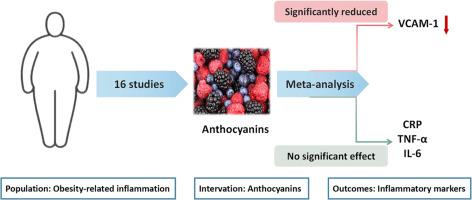Nutrition Research ( IF 3.4 ) Pub Date : 2023-05-24 , DOI: 10.1016/j.nutres.2023.05.009 Wanhan Song 1 , Qianhua Yuan 1 , Ya Wang 1 , Meiqing Mai 1 , Mengliu Luo 1 , Honghui Guo 2

|
The relationship between anthocyanin intake and obesity-related inflammatory markers remains unclear in existing research. To investigate this, we hypothesized that anthocyanin supplementation could reduce plasma concentrations of inflammatory markers, including C-reactive protein (CRP), tumor necrosis factor alpha (TNF-α), interleukin-6 (IL-6), vascular cell adhesion molecule-1, and other cytokines in obesity. We conducted a systematic search of PubMed, Web of Science, Scopus, SinoMed, and other related literature and identified 16 randomized controlled trials that met our inclusion criteria. Our findings showed that anthocyanin intake was significantly associated with a reduction in vascular cell adhesion molecule-1 mean plasma concentrations (–53.56 ng/mL; 95% confidence interval [CI], –82.10 to –25.03). We also observed a modest decrease in CRP (–0.27 ng/mL; 95% CI, –0.58 to 0.05), TNF-α (–0.20 ng/mL; 95% CI, –0.54 to 0.15), and IL-6 (–0.53 ng/mL; 95% CI, –1.16 to 0.10) mean plasma concentrations. Subgroup analysis revealed that anthocyanin intake tended to decrease CRP and IL-6 concentrations in overweight or dyslipidemic individuals. Additionally, the intervention duration subgroup analysis showed that anthocyanin supplementation had a stronger effect on plasma IL-6 and TNF-α in participants after 8 to 12 weeks of intervention. In conclusion, our meta-analysis indicated that anthocyanin supplementation can effectively reduce obesity-related inflammatory markers associated with chronic low-grade inflammation.
中文翻译:

花青素补充剂改善肥胖相关炎症特征:随机对照试验的系统回顾和荟萃分析
现有研究中,花青素摄入量与肥胖相关炎症标志物之间的关系仍不清楚。为了研究这一点,我们假设补充花青素可以降低炎症标志物的血浆浓度,包括 C 反应蛋白 (CRP)、肿瘤坏死因子 α (TNF-α)、白细胞介素 6 (IL-6)、血管细胞粘附分子 - 1、肥胖中的其他细胞因子。我们对 PubMed、Web of Science、Scopus、SinoMed 和其他相关文献进行了系统检索,并确定了 16 项符合我们纳入标准的随机对照试验。我们的研究结果表明,花青素摄入量与血管细胞粘附分子-1 平均血浆浓度的降低显着相关(–53.56 ng/mL;95% 置信区间 [CI],–82.10 至 –25.03)。我们还观察到 CRP(–0.27 ng/mL;95% CI,–0.58 至 0.05)、TNF-α(–0.20 ng/mL;95% CI,–0.54 至 0.15)和 IL-6 略有下降( –0.53 ng/mL;95% CI,–1.16 至 0.10) 平均血浆浓度。亚组分析显示,摄入花青素往往会降低超重或血脂异常个体的 CRP 和 IL-6 浓度。此外,干预持续时间亚组分析显示,干预 8 至 12 周后,补充花青素对参与者的血浆 IL-6 和 TNF-α 具有更强的影响。总之,我们的荟萃分析表明,补充花青素可以有效减少与慢性低度炎症相关的肥胖相关炎症标志物。


















































 京公网安备 11010802027423号
京公网安备 11010802027423号